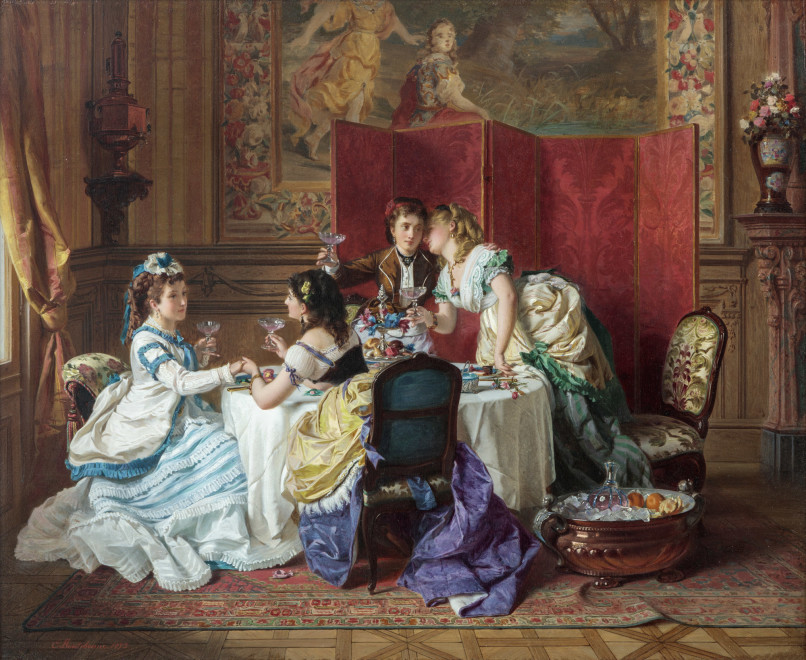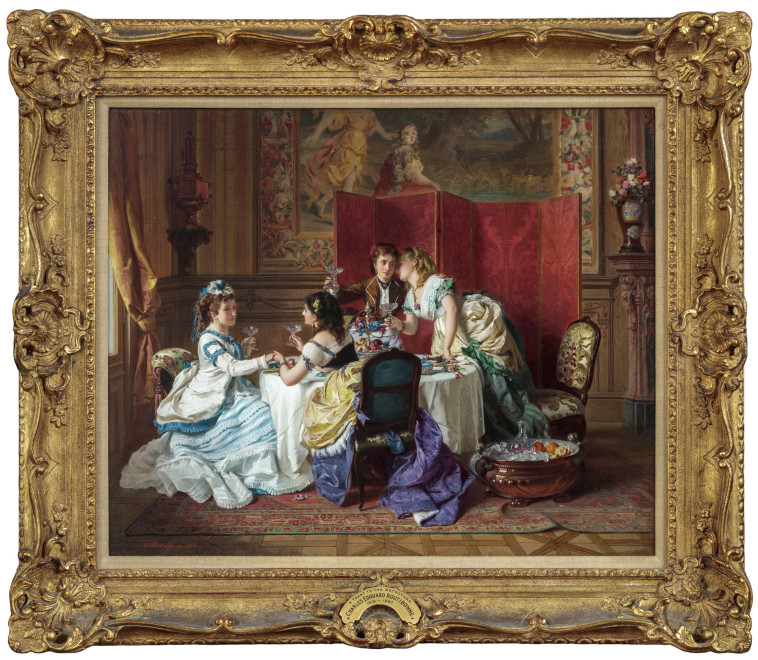A Toast to the Betrothed travelled upstate to hang in shipping magnate William Brown Dinsmore’s country estate in Staatsburgh along the scenic Hudson river.
Provenance
Goupil & cie, Paris, 1873 (no. 8224, acquired directly from the artist)
W. B. Dinsmore, New York, 1873 (through Knoedler & co, New York)
Sale: Butterfields, San Francisco, 19 June 1991, lot 1736
Acquired by the present owner at the above sale
Catalogue note
In the late nineteenth century, Charles Édouard Boutibonne was celebrated for his compositions of outdoor activities as well as scenes of social dramas starring fashionably dressed women in elaborately appointed interiors. With A Toast to the Betrothed, Boutibonne pairs exquisite details of rich tapestry and upholsteries, warm tones of boiserie, and sparkling table settings with the varied hues and textures of costumes worn by celebrating ladies, who toast the soon-to-be bride on the news of her betrothal. The artist captures the eye with intricate details of peeled oranges and crystal carafes resting on ice in a brass wine cooler— as well as the distracted attention of woman listening to the close whispers of her tablemate, slyly suggesting not all guests are celebrating the happy couple.
Soon after it was painted in 1873, A Toast to the Betrothed was acquired by Goupil, the Paris-based dealers, and their New York associates Knoedler & Co, who were responsible for placing Boutibonne’s work in prominent American Gilded Age collections from the Northeast through the Midwest. While Boutibonne’s works hung prominently in the impressive mansions of New York’s wealthy industrialists, A Toast to the Betrothed travelled upstate to hang in shipping magnate William Brown Dinsmore’s country estate in Staatsburgh along the scenic Hudson river. Though Dinsmore’s country life may have been an escape from the city, a grand home with fine art and decoration remained an important status symbol for the wealthy, and afforded artists and their dealers new opportunities for patronage.
William Brown Dinsmore (1810-1888) built his fortune in railroads and shipping, serving as president of the Adams Express Company (still in operation today). In the 1850s he purchased Staatsburgh’s “The Locusts”, named for the black locust trees growing on the vast estate first developed in the late eighteenth century, tearing down the existing residence and, in 1871, began construction on a ninety-two room, four story Italianate villa. In addition to A Toast for the Betrothed, Dinsmore bought other works from Knoedler by Pierre Auguste Cot, Auguste Toulmouche and other French contemporary artists in the spring and summer of 1873. In the same year, Dinsmore acquired Albert Bierstadt’s epic canvas Among the Sierra Nevada, California (1868), later bequeathed to the Smithsonian American Art Museum. Dinsmore was a passionate horticulturist, and the beauty of his home was matched by expansive manicured lawns, elaborate gardens and greenhouses of exotic flowers on the fifty-to-sixty-acre property. The Locusts was included in late nineteenth century guidebooks to the Hudson Valley and was visited by the era’s notable figures, including President Chester A. Arthur in 1884. As an accompanying journalist then described: “The Dinsmore mansion is one of the largest and handsomest summer houses in the state…. The furniture [and interior decoration] is of a costly kind…. The Presidential party were greatly entertained with everything about the home” including a feast of “delicacies” not unlike those depicted in Boutibonne’s composition.[1] Following Dinsmore’s death in 1888, more than 100 paintings from his estate were auctioned while others remained with the home, which passed down through the family. Dinsmore’s granddaughter Helen Dinsmore Huntington demolished the villa in 1941, replacing it with a Neobaroque style mansion.




